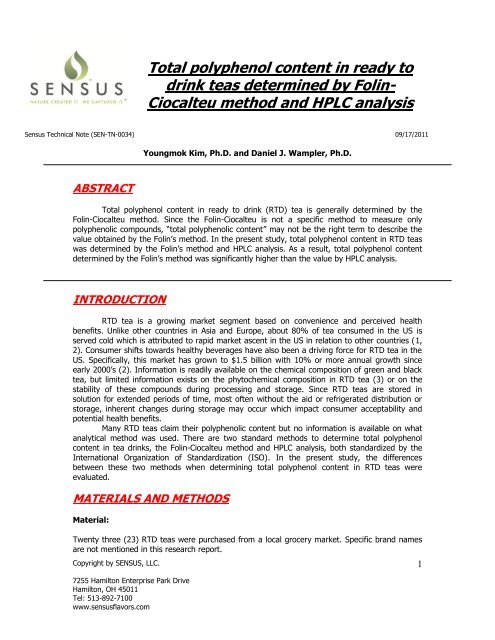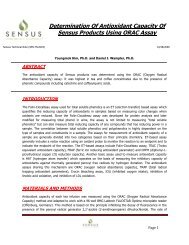Total polyphenol content in ready to drink teas determined by ...Folin ...
Total polyphenol content in ready to drink teas determined by ...Folin ...
Total polyphenol content in ready to drink teas determined by ...Folin ...
Create successful ePaper yourself
Turn your PDF publications into a flip-book with our unique Google optimized e-Paper software.
<strong>Total</strong> <strong>polyphenol</strong> <strong>content</strong> <strong>in</strong> <strong>ready</strong> <strong>to</strong>dr<strong>in</strong>k <strong>teas</strong> determ<strong>in</strong>ed <strong>by</strong> Fol<strong>in</strong>-Ciocalteu method and HPLC analysisSensus Technical Note (SEN-TN-0034) 09/17/2011Youngmok Kim, Ph.D. and Daniel J. Wampler, Ph.D.ABSTRACT<strong>Total</strong> <strong>polyphenol</strong> <strong>content</strong> <strong>in</strong> <strong>ready</strong> <strong>to</strong> dr<strong>in</strong>k (RTD) tea is generally determ<strong>in</strong>ed <strong>by</strong> theFol<strong>in</strong>-Ciocalteu method. S<strong>in</strong>ce the Fol<strong>in</strong>-Ciocalteu is not a specific method <strong>to</strong> measure only<strong>polyphenol</strong>ic compounds, “<strong>to</strong>tal <strong>polyphenol</strong>ic <strong>content</strong>” may not be the right term <strong>to</strong> describe thevalue obta<strong>in</strong>ed <strong>by</strong> the Fol<strong>in</strong>’s method. In the present study, <strong>to</strong>tal <strong>polyphenol</strong> <strong>content</strong> <strong>in</strong> RTD <strong>teas</strong>was determ<strong>in</strong>ed <strong>by</strong> the Fol<strong>in</strong>’s method and HPLC analysis. As a result, <strong>to</strong>tal <strong>polyphenol</strong> <strong>content</strong>determ<strong>in</strong>ed <strong>by</strong> the Fol<strong>in</strong>’s method was significantly higher than the value <strong>by</strong> HPLC analysis.INTRODUCTIONRTD tea is a grow<strong>in</strong>g market segment based on convenience and perceived healthbenefits. Unlike other countries <strong>in</strong> Asia and Europe, about 80% of tea consumed <strong>in</strong> the US isserved cold which is attributed <strong>to</strong> rapid market ascent <strong>in</strong> the US <strong>in</strong> relation <strong>to</strong> other countries (1,2). Consumer shifts <strong>to</strong>wards healthy beverages have also been a driv<strong>in</strong>g force for RTD tea <strong>in</strong> theUS. Specifically, this market has grown <strong>to</strong> $1.5 billion with 10% or more annual growth s<strong>in</strong>ceearly 2000’s (2). Information is readily available on the chemical composition of green and blacktea, but limited <strong>in</strong>formation exists on the phy<strong>to</strong>chemical composition <strong>in</strong> RTD tea (3) or on thestability of these compounds dur<strong>in</strong>g process<strong>in</strong>g and s<strong>to</strong>rage. S<strong>in</strong>ce RTD <strong>teas</strong> are s<strong>to</strong>red <strong>in</strong>solution for extended periods of time, most often without the aid or refrigerated distribution ors<strong>to</strong>rage, <strong>in</strong>herent changes dur<strong>in</strong>g s<strong>to</strong>rage may occur which impact consumer acceptability andpotential health benefits.Many RTD <strong>teas</strong> claim their <strong>polyphenol</strong>ic <strong>content</strong> but no <strong>in</strong>formation is available on whatanalytical method was used. There are two standard methods <strong>to</strong> determ<strong>in</strong>e <strong>to</strong>tal <strong>polyphenol</strong><strong>content</strong> <strong>in</strong> tea dr<strong>in</strong>ks, the Fol<strong>in</strong>-Ciocalteu method and HPLC analysis, both standardized <strong>by</strong> theInternational Organization of Standardization (ISO). In the present study, the differencesbetween these two methods when determ<strong>in</strong><strong>in</strong>g <strong>to</strong>tal <strong>polyphenol</strong> <strong>content</strong> <strong>in</strong> RTD <strong>teas</strong> wereevaluated.MATERIALS AND METHODSMaterial:Twenty three (23) RTD <strong>teas</strong> were purchased from a local grocery market. Specific brand namesare not mentioned <strong>in</strong> this research report.Copyright <strong>by</strong> SENSUS, LLC.7255 Hamil<strong>to</strong>n Enterprise Park DriveHamil<strong>to</strong>n, OH 45011Tel: 513-892-7100www.sensusflavors.com1
Analytical Methods:1. Fol<strong>in</strong>-Ciocalteu method: <strong>Total</strong> <strong>polyphenol</strong> <strong>content</strong> (also known as <strong>to</strong>tal soluble phenolics)was determ<strong>in</strong>ed us<strong>in</strong>g Fol<strong>in</strong>-Ciocalteau assay as described <strong>by</strong> Swa<strong>in</strong> and Hillis (4). In brief,300 µL of each tea was added <strong>to</strong> test tubes and mixed with 1mL of 0.2N Fol<strong>in</strong>’s reagent.After 3 m<strong>in</strong> of reaction, 1 mL of sodium carbonate solution was added <strong>to</strong> s<strong>to</strong>p the reactionand <strong>to</strong> develop characteristic blue color for 7 m<strong>in</strong>. Seven mL of purified water was addedafter that. Absorbance was measured at 726 nm and the <strong>to</strong>tal phenolic <strong>content</strong> wascalculated based on slope from serial dilution of a gallic acid standard. The f<strong>in</strong>al value wasexpressed as gallic acid equivalent.2. HPLC green tea analysis: Each green tea <strong>in</strong>fusion was diluted 3-fold with reverse osmosis(RO) water and filtered through a 0.45 μm PTFE syr<strong>in</strong>ge filter (Whatman, Clif<strong>to</strong>n, NJ) prior<strong>to</strong> <strong>in</strong>jection. Polyphenolic separations was conducted on a Agilent 1200 HPLC system us<strong>in</strong>ga Agilent G1315B Diode Array Detec<strong>to</strong>r (DAD) with a Dionex 250 x 4.6 mm Acclaim 120-C 18column with a flow rate of 0.8 mL/m<strong>in</strong>. A gradient mobile phase consisted of Phase A (100%H 2 O) and Phase B (60% Methanol and 40% H 2 O) each adjusted <strong>to</strong> pH 2.4 us<strong>in</strong>g o-phosphoric acid. The gradient started <strong>by</strong> runn<strong>in</strong>g 0% Phase B for 1m<strong>in</strong>, 0-30% Phase Bover 30m<strong>in</strong>, 30-80% Phase B <strong>in</strong> 15m<strong>in</strong>, 80-100% Phase B <strong>in</strong> 15m<strong>in</strong>, followed <strong>by</strong> a 5 m<strong>in</strong>uteequilibration time with 100% phase A for a <strong>to</strong>tal run time of 65m<strong>in</strong>. Polyphenol compoundswere detected and quantified at 280 nm aga<strong>in</strong>st external standards of gallic acid,theobrom<strong>in</strong>e, (−)-epicatech<strong>in</strong>, (−)-epigallotcatech<strong>in</strong> gallate, (−)-epigallocatech<strong>in</strong>, (−)-epicatech<strong>in</strong> gallate, and caffe<strong>in</strong>e, all procured from Chromadex (Chromadex Inc., Irv<strong>in</strong>e,CA).3. HPLC black tea analysis: Each black tea <strong>in</strong>fusion was also properly diluted and <strong>in</strong>jected <strong>to</strong>Agilent 1200 HPLC system with a ES <strong>in</strong>dustry FluoroSep-RP 150 X 4.6mm 5µm column witha flow rate of 1.0 mL/m<strong>in</strong>. A gradient mobile phase consisted of Phase A (97% water, 2%Ace<strong>to</strong>nitrile, 1% Methanol, and 0.1% phosphoric acid), Phase B (100% Ace<strong>to</strong>nitrile), andPhase C (100% methanol) each adjusted <strong>to</strong> pH 2.4 us<strong>in</strong>g o-phosphoric acid. <strong>Total</strong> run timewas 38m<strong>in</strong> and <strong>polyphenol</strong> compounds were detected and quantified at 278 nm aga<strong>in</strong>stexternal standards of theaflav<strong>in</strong>, theaflav<strong>in</strong> monogallate, and theaflav<strong>in</strong> digallate, allprocured from Chromadex (Chromadex Inc., Irv<strong>in</strong>e, CA).RESULTS AND DISCUSSIONOverall, <strong>to</strong>tal <strong>polyphenol</strong> <strong>content</strong> determ<strong>in</strong>ed <strong>by</strong> the Fol<strong>in</strong>’s method showed significantlyhigher quantity compared <strong>to</strong> the value <strong>by</strong> HPLC analysis (Figure 1). Accord<strong>in</strong>g <strong>to</strong> Brunswicklabora<strong>to</strong>ry, one of the largest antioxidant research facilities <strong>in</strong> the nation, the Fol<strong>in</strong>’s method isdef<strong>in</strong>ed as “the Fol<strong>in</strong>-Ciocalteu measures reduc<strong>in</strong>g capacity, which has normally been used <strong>to</strong>estimate phenolic <strong>content</strong>s of biological materials.” S<strong>in</strong>ce the Fol<strong>in</strong>’s method detects not only<strong>polyphenol</strong>ic compounds but also other biological compounds that have reduc<strong>in</strong>g power such asam<strong>in</strong>o acids, carbohydrates, ascorbic acid, and sapon<strong>in</strong> which are all naturally present <strong>in</strong> tea, thevalue <strong>by</strong> Fol<strong>in</strong>’s method might be higher than the value <strong>by</strong> HPLC. An addition of ascorbic acid <strong>to</strong>RTD <strong>teas</strong> and us<strong>in</strong>g color<strong>in</strong>g material such as caramel color also <strong>in</strong>creases the value <strong>by</strong> Fol<strong>in</strong>.Copyright <strong>by</strong> SENSUS, LLC.7255 Hamil<strong>to</strong>n Enterprise Park DriveHamil<strong>to</strong>n, OH 45011Tel: 513-892-7100www.sensusflavors.com2
mg/240mLS<strong>in</strong>ce those compounds (am<strong>in</strong>o acids, ascorbic acid, carbohydrate, sapon<strong>in</strong>, and caramel color)are not <strong>polyphenol</strong>s, the value determ<strong>in</strong>ed <strong>by</strong> the Fol<strong>in</strong>’s method could mislead health conscioustea dr<strong>in</strong>kers.Fol<strong>in</strong> vs. HPLC200180160Fol<strong>in</strong>HPLC1401201008060402001 2 3 4 5 6 7 8 9 10 11 12 13 14 15 16 17 18 19 20 21 22 23RTD <strong>teas</strong>Figure 1. <strong>Total</strong> <strong>polyphenol</strong> <strong>content</strong> determ<strong>in</strong>ed <strong>by</strong> Fol<strong>in</strong>-Ciocalteu and HPLC analysis.CONCLUSIONThe two approved methods of determ<strong>in</strong>e <strong>polyphenol</strong>ic <strong>content</strong> of RTD <strong>teas</strong>, the Fol<strong>in</strong>-Ciocalteu chemical method and the HPLC <strong>in</strong>strumental method. The two methods are different,with different advantages and disadvantages. Us<strong>in</strong>g the Fol<strong>in</strong>’s method <strong>to</strong> determ<strong>in</strong>e <strong>to</strong>tal<strong>polyphenol</strong> <strong>content</strong> <strong>in</strong> RTD <strong>teas</strong> may mislead consumers because the true <strong>polyphenol</strong>ic <strong>content</strong> isoverstated.REFERENCE CITED1. Rijken,P. J; Wiseman, S. A; Weisgerber, U. T; van Mierlo, C. A. J; Qu<strong>in</strong>lan, P. T; van de put, F.,Antioxidant and other properties of green and black tea. In Handbook of Antioxidants. Secondedition. Revised and expanded. Cadenas, E., Packer, L., Eds.; Marcel Dekker Inc: New York,NY, 2002; pp 371-400.2. Simrany, J. The state of the tea <strong>in</strong>dustry. Tea and Coffee Trade Journal. 2000.Available onl<strong>in</strong>e: http://www.teaandcoffee.net/0100/tea.htm3. Chen, Z.; Zhu, Q. Y.; Tsang, D.; Huang, Y. Degradation of green tea catech<strong>in</strong>s <strong>in</strong> tea dr<strong>in</strong>ks. J.Agric. Food Chem. 2001, 49, 477-482.4. Swa<strong>in</strong>, T.; Hillis, W. E. The phenolic constituents of Purmus domestica. I. The quantitativeanalysis of phenolic constituents. J. Sci. Food. Agric. 1959, 10, 63-68.Copyright <strong>by</strong> SENSUS, LLC.37255 Hamil<strong>to</strong>n Enterprise Park DriveHamil<strong>to</strong>n, OH 45011Tel: 513-892-7100www.sensusflavors.com



